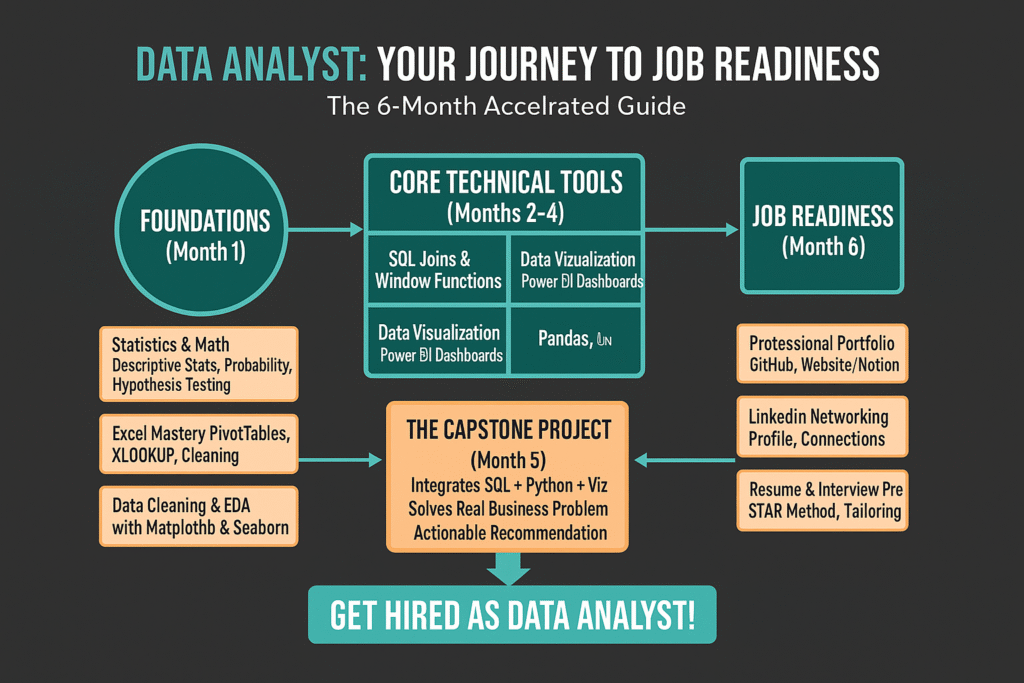
Look, if you’re fresh out of college and staring at data analyst job postings that ask for “3+ years experience,” I get it. The whole field can feel overwhelming. But here’s the thing—you don’t need a perfect map. You need a real plan that actually works.
I’ve watched too many aspiring analysts spin their wheels learning random skills in isolation. The truth? Companies don’t care if you know every Excel function. They care if you can take messy data and turn it into decisions they can act on. That’s what this data analyst roadmap for freshers delivers: a structured 6-month plan that gets you from complete beginner to someone with a portfolio that actually impresses hiring managers.
Phase 1: Build Your Analyst Brain (Weeks 1-3)
What mindset separates good analysts from the rest?
Here’s what nobody tells you: the best analysts aren’t code wizards first. They’re problem solvers who happen to use data. Your first three weeks aren’t about memorising formulas—they’re about building the mental framework every analyst needs. Core skills you’ll master:- Excel formulas like VLOOKUP, INDEX-MATCH combinations, and PIVOT TABLES
- Data cleaning functions, including TRIM and conditional IF statements
- Summarising raw data into actionable insights
Phase 2: Learn the Language of Data (Weeks 4-7)
Why does every data analyst job listing demand SQL?
Because if the data matters to a business, it lives in a database. And databases only speak one language: SQL. This isn’t optional—it’s the skill that gets you in the door. Don’t waste time on beginner tutorials that only teach SELECT and FROM. You need to jump into the deep end with these essential skills:- All JOIN types: INNER, LEFT, RIGHT, and FULL joins
- Advanced filtering: CASE statements for conditional logic
- Efficient querying: Subqueries and CTEs (Common Table Expressions)
Phase 3: Make Your Data Tell Stories (Weeks 8-11)
How do you turn analysis into action?
This is where most analysts fail. You can have the perfect dataset and brilliant insights, but if you can’t communicate them visually, they die in your Excel file. This phase transforms you from someone who finds answers to someone who creates change. Pick either Tableau or Power BI (both are industry standards—choose based on what’s popular in your target companies). Focus on these key principles:- Connecting to various data sources (SQL databases, CSV files)
- Creating calculated fields for custom metrics
- Designing professional dashboards using Data-Ink Ratio and Gestalt Principles
Phase 4: Add Python to Your Toolkit (Weeks 12-16)
Where does Python fit for analysts?
Think of it this way: SQL extracts data, BI tools present it, and Python handles everything in between that’s too complex for the others. It’s your power tool for serious data cleaning, transformation, and exploratory analysis. Your Python essentials:- Setup: Get comfortable with Jupyter Notebooks for interactive analysis
- Pandas: Master DataFrames, groupby, merge, and concat operations
- NumPy: Learn numerical operations for efficient calculations
- Visualisation: Create basic plots with Matplotlib or Seaborn
- Keep paragraphs short (2-4 sentences maximum)
- Use bullet points to break up dense methodology sections
- Bold key takeaways to help readers (and search engines) extract information quickly
Phase 5: Build Your Job-Winning Project (Weeks 17-20)
Why do you absolutely need a capstone project?
Because hiring managers don’t trust tutorials—they trust proof. Your capstone is the project that demonstrates you can handle the full lifecycle of analysis: pulling data with SQL, cleaning and analysing with Python, and presenting insights through visualisation. This can’t be a textbook exercise. Define a real business problem. Your project must showcase:- Real-world application: A genuine business scenario (customer churn, inventory optimisation, employee turnover)
- Your unique methodology: How you approached the problem differently
- Actionable recommendations: What specific steps a business should take based on your findings
- The business problem you’re solving
- Your methodology and tools used
- Your key findings and insights
- Your final business recommendation (most important!)
How This Data Analyst Roadmap for Freshers Prepares You for Interviews (Weeks 21+)
What’s the last step to actually land the job?
You’ve built the skills. Now you have to sell them. The final phase is about communication and confidence in the interview process. Your interview prep checklist:- Master the STAR method for behavioural questions (Situation, Task, Action, Result)
- Practice SQL live coding on platforms like HackerRank or LeetCode
- Rehearse your project presentations until they sound conversational, not scripted
- Network actively on LinkedIn and attend data meetups in your area
